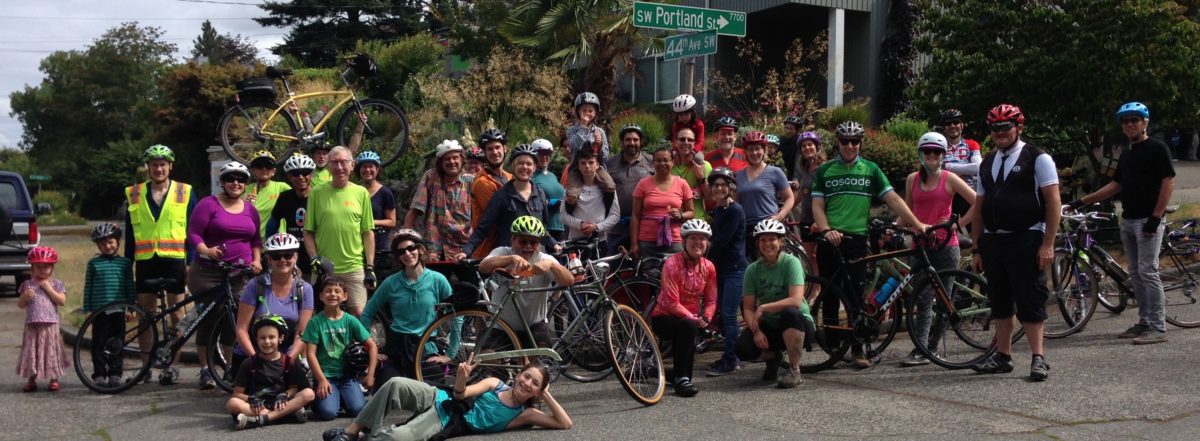What? Isn’t this a bike blog? Why freight? Because…
1. We live on a peninsula. To get to Seattle we need to go across bridges and on routes that are also, and primarily, major truck routes though the Duwamish manufacturing and industrial center and the Port of Seattle seaport and rail yards.
2. We need jobs. These manufacturing areas and the port are the drivers of our economy. Lots of us are riding to jobs directly connected to the port, freight transfer, world trade and manufacturing that depends on freight. We all need to consume goods brought by ship, rail and truck. The deep water seaport on Elliott Bay remains the primary reason that Seattle exists as a city.
3. We have hills. Bikes and trucks both need relatively gentle grades. The street that angle across the hills or run on the flats. We have to share those grades and co-exist.
At today’s meeting:
- Video shown from the Bike & Truck Safety Fair, and thanks to all who participated! Could become annual. Photos and video will be shared soon.
- Freight Advisory Board comments on the Waterfront EIS. Trucking companies have the same concerns as bike riders: will we be able to get through it smoothly without delay after the tunnel and waterfront are done?
- WSDOT freight plan. Barbara Ivanov from WSDOT presented the state’s freight plan for highways, marine and rail. Focus on bottlenecks. All slow speed bottlenecks on WA freeways are in central Puget Sound (surprise!) esp I-5 though Seattle and I-405 in Renton. For non-freeway highways, northbound 99 south of 1st Ave bridge is a poster child bottleneck, with posted speed limit of 40 and actual average speed of 22. Basically, that speed make bikes competitive for freight hauling. Well, at least it shows that if we can more people out of cars that are slowing down trucks and onto bikes traveling safely beside trucks, we can help improve freight mobility and our economy. Why are our highways and bridges in such bad shape? Legislators pass funding for new projects but not for preservation of existing highways and bridges, and the gas tax is declining, and WA does not have an income tax or use general funds for state highways. (Local streets are funded by property tax, NOT by gas tax).
- SDOT ITS initiative: information technology to manage traffic flow and make it more efficient. SDOT has completed a study but not funded implementation of ways to use LOTS of expensive information technology to get real time feedback on traffic conditions to signals, readerboard signs, online traffic flow maps and more from social media, etc. Sounds fine for signals and road signs. Sound really scary for all the cool ways people could use their smart phones in their vehicles instead of actually paying attention to the road around them. This needs some attention and severe editing. Another option to spending 10’s of millions on IT: Spend hundreds of thousands on bike routes and just ride. It does not take any more IT than the weather report.
- SDOT/Port of Seattle Industrial Areas Action Project: Tony Mazella reported on this project for the Duwamish and the Ballard (Interbay) Manufacturing and Industrial Centers (MICs). It will identify improvement projects within and between these areas and from them to highways, intermodal yards, shipping terminals. Draft in spring 2014. Stakeholder outreach now. These routes coincide with bike routes in many cases.
- SDOT Freight Master Plan: Work beginning soon. Same team as for Bike Master Plan, which is encouraging for integration of the two. Sara Zora presented. As with the BMP, the street network definition is a key element. For City policy, the Freight, Bike, Transit and Pedestrian Master Plans are Modal Plans. They, along with Operations Plan and SubArea Plan, flow from the Transportation Strategic Plan.The Transportation Strategic Plan and the Climate Action Plan flow from the Comprehensive Plan.
- SDOT Capital Projects: Art Brochet reported on their current list of large projects, and offered to give the FAB briefings on projects of interest at 30% design stage for design input and near bid stage for construction detours and other mitigation during construction. Lots of these involve arterials and bridges of interest for bike transportation, too.

